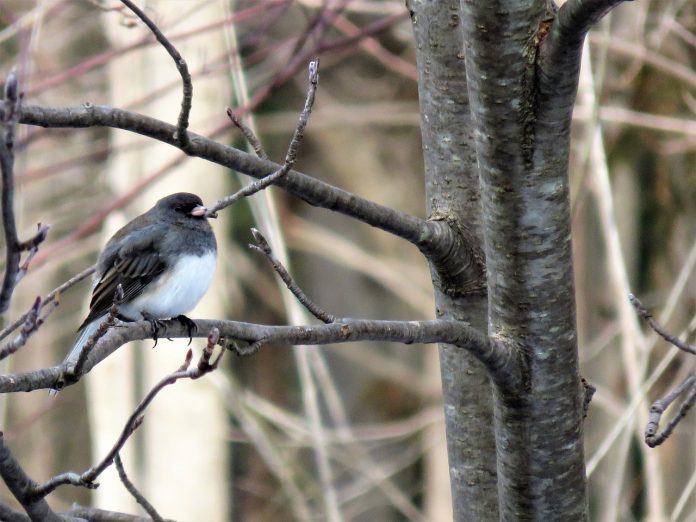Every year as the sun rises earlier and sets later, I get antsy. I’m ready for winter to end and spring to begin.
So I keep my eyes on the juncos at the feeders. They arrive each fall in late October or early November and stay the winter. Their return north in April is a sure sign that winter’s really over.
Juncos, or snowbirds as they’re often called, define the end of winter and the onset of spring for observant nature watchers.
Habitat
Dark-eyed juncos breed in northern forests all the way to the tundra. They find temperate winters downright balmy.
Permanent populations also live at higher elevations throughout the Appalachian Mountains. They nest in younger coniferous and mixed forests and rhododendron thickets.
Appearance
Juncos are among the easiest feeder birds to identify. The male’s slate gray head, neck, back and upper breast contrast sharply with its snow-white belly and lower breast.
And in flight, white outer tail feathers flash conspicuously. Add a distinctly pink bill, and he’s complete.
Females are patterned similarly, but their dark parts are more brownish-gray.
The “slate-colored” dark-eyed junco is just one of several forms that occur across North America.
Far western “Oregon” juncos wear a black hood that contrasts with a rusty back. The “white-winged” form of the Black Hills has two white wing bars and more white on the tail.
The southern Rockies’ “gray-headed” form has a bright rusty back. And the “pink-sided” form of the northern Rockies has broad pink sides.
Hybrids of some of these forms occur, so watch for variations in the “slate-colored” form that occurs throughout the East.
According to the Cornell Laboratory of Ornithology’s Project FeederWatch, juncos are often seen at more feeders across the continent than any other species.
They prefer white millet, cracked corn, and black-oil sunflower seeds scattered on the ground or on low platform feeders.
Winter flocks of juncos number 10 to 30 individuals. If you watch the juncos that come to your yard carefully, you’ll notice two things.
Flocks
First, you’ll only see one flock at a time. Winter flocks defend feeding territories — they don’t tolerate intrusions from other flocks. Unless it gets really cold and snowy.
I’ve counted as many as 47 juncos beneath my feeders during a snowstorm.
Second, within a flock, there is a definite social hierarchy or pecking order. Adult males occupy the top rung of the social ladder, followed by young males, adult females, and finally, young females.
Dominant individuals eat first. Lower ranking juncos wait their turn.
Early in the morning and late in the day, when feeding is most intense, you’re most likely to observe aggression between dominant and subordinate individuals.
Dominance is probably determined by a combination of age, gender and experience.
Reproduction
When juncos head north in April, their instincts shift from winter survival to reproduction.
Longer days trigger hormonal changes in males that cause them to sing a musical trill from the tops of the tallest trees. The monotone song is easy to recognize, though it might be confused with a chipping sparrow’s song.
Parallel hormonal changes in females make the males’ song attractive and pairing occurs. Though males help gather nesting material, the female builds the nest alone.
It’s usually on the ground hidden under roots, a log, a rocky ledge, or an overhanging bank along a stream or road.
The female lays four or five eggs and incubates them for about 12 days. Thanks to fast-growing feet and legs, nestlings can leave the nest on foot when danger threatens as soon as nine days after hatching.
Normally they fledge in 12 to 13 days. After the nesting season, which may include two broods, shorter days and plunging temperatures send them back to us for the winter.
The calendar may tell us spring’s just a month away. But I’ll wait for the juncos to leave before I feel confident that spring is coming. I just can’t shake the memories of the blizzard of March 1993.













